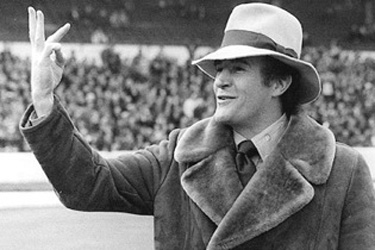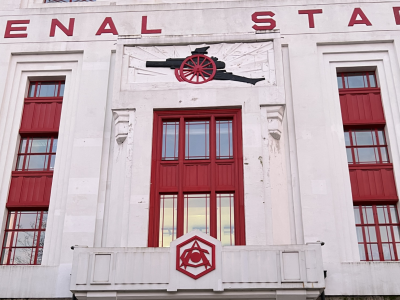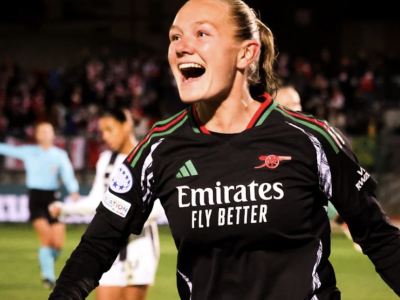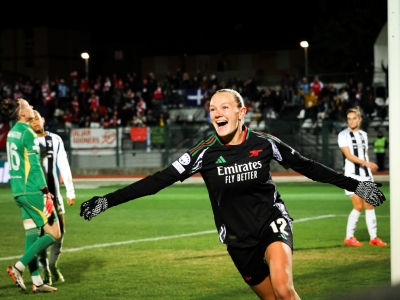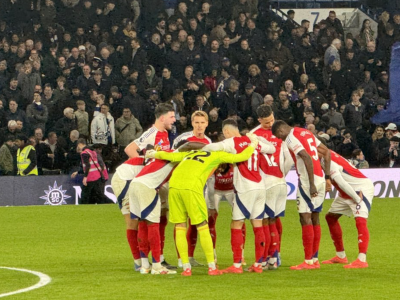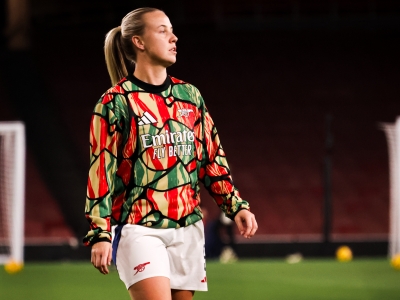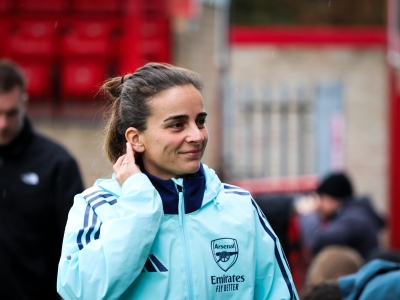The first visit of Crystal Palace to Highbury came in the fourth round of the FA Cup in 1934. At the time, Crystal Palace were a third tier side, who were founder members of the Division when it was created in 1920 from clubs drawn entirely from the top tier of the Southern League (with no representation north of Birmingham until the North/South divisional split was created the following year). Palace won the inaugural Third Division title in 1920/21 and were promoted to the Second tier, though after four seasons dropped back down into what was now the Third Division South and were still there by the time of their visit to Highbury.
Palace couldn’t have asked for a bigger tie, as the Gunners were reigning Champions and at the time top of the old First Division. The Gulf in quality showed itself however as Arsenal thrashed Palace 7-0 with goals from Ralph Birkett and two goals apiece for Pat Beasley, Jimmy Dunne and Cliff Bastin. Arsenal would in fact cause the exit of Crystal Palace from the FA Cup twice in three seasons, the second time in the Second Round of the Cup in December 1935 however was not direct competition between the two sides, but at the hands of Arsenal’s nursery side, non-league Margate F.C., who at the time were playing in the Southern League.
Arsenal’s links with Margate started when the Gunners signed the Dutch former Ajax goalkeeper Gerrit Keizer who was turning out for the Kentish side in 1930 (highly unusual for any players from the continent to be plying their trade in England during the period). Four years later they came upon Arsenal’s radar again as manager George Allison’s daughter was a teacher at a school in the area. That year the club signed a two year deal with Arsenal to act as a nursery club (something the club tried a few years earlier with Clapton Orient, but such a move was later prohibited by the Football League between member clubs). The agreement with Margate included Arsenal appointing them a manager – former Gunners player Jack lambert - and even the insistence that Margate shrink their pitch down to match the same configurations as Highbury.
Other terms of the agreement included the loaning of upcoming younger players (though first teamer Eddie Hapgood also turned out for them after returning to action after injury). As a result of this agreement with Margate, Arsenal also disband their ‘A’ team (founded in 1929 to field younger players). The agreement with Margate last four years until in 1958, Arsenal entered their own reserve side into the Southern League. In the 1935/36 FA Cup, Margate managed to reach the First Round and were drawn at home to QPR – then in the Third Division South and only just returned back to their Loftus Road home from a brief two-year spell at the White City Stadium (which hosted London’s 1908 Olympic Games).
Margate won the tie 3-1, which brought another home tie against a London club who used to play their home games at another of the Capital’s major historical sporting landmarks – Crystal Palace. The Kentish seasiders managed to pull off another coup, beating Palace 3-1 (@01.50) . Margate progressed to the third round to play another seaside outfit in Blackpool (then of the old Second Division. This time however, Margate were on the receiving end of a 1-3 defeat. Margate would play two further FA Cup ties with Palace – a 2-3 loss in the First Round in 1957, as well as two seasons later in the second round when Margate held Palace to a 0-0 draw at home, though lost the replay at Selhurst Park.
Margate’s most notable FA Cup encounter however came in the centenary year of the competition in 1972, after losing 11-0 to AFC Bournemouth, where Ted MacDougall scored nine goals for the latter. Margate’s goalkeeper that day, Chic Brodie, had also been attempting to revive his career in non-league Football after his leg was broken while playing for Brentford after being attacked by an over-excited Jack Russell dog which strayed onto the pitch during a televised game against Colchester and chased the entire length of the pitch after the ball which had just been played into Brodie’s hands (‘what a great tackle’, ITV commentator Gerry Harrison rather insensitively states!).
As for Palace, they remained in the Third Division South until the regional split was abolished in 1958. The came runners up in the Division in 1938/39, however were not promoted on account of the fact that only the Divisional Champions went up. On Palace’s books at the time of their first visit to Highbury in 1934 was Ronnie Rooke, who joined Arsenal at the age of thirty five in 1946 and was a prominent figure within The Gunners’ 1947/48 Championship winning side. Rooke held an incredible scoring record of sixty eight goals in just eighty eight games for the Arsenal (all the more incredible seeing that he was in his late thirties!), though left Highbury in 1949 to return to Crystal Palace as Player-Manager.
After a poor start to the 1950/51 season however, Rooke lost his job and Palace looked to Highbury again for the replacement. Gunners full back Laurie Scott also took over as Player-Manager, though feared little better and too was sacked after Palace had to apply for re-election to the League after finishing in the bottom three at the end of 1953/54. The abolition of the regional split in 1958 saw Crystal Palace drop into the Fourth Division, however after three seasons down there the club won their first post-war promotion in 1960/61 finishing as runners up under Arthur Rowe – the former Spurs ‘push and run’ 1951 title winning manager.
Rowe was forced to quit Spurs in 1955 due to a nervous breakdown. The same health issues blighted Rowe again at Palace when he stepped aside for Dick Graham to take over but remained on the coaching staff. Graham saw them promoted again to the second tier in 1963/64, fired by the goals of former Arsenal star Cliff Holton. Palace reached the Quarter Finals of the FA Cup in 1965 against Don Revie’s Leeds United, however lost 0-3 at Selhurst Park. Palace’s first game on Match of the Day followed the following October against Wolves in late October 1965. According to Kenneth Wolstenholme’s introduction, the game seemed to have kicked off thirty two minutes late due to Crystal Palace experiencing travel problems. Ken ponders on whether the journey would have upset Palace on the field. In the event, they lost 0-1 to Wolves.
Crystal Palace remained in the second tier until they achieved promotion to the top flight for the first time in their history in 1969, under the stewardship of Bertram James Head (if you thought his initials were funny in a Carry On sort of way, his more commonly known name of Bert Head, when put into a Google image search, hilariously comes back with a headshot picture of the Sesame Street character who co-habits with his friend Ernie!). Bert joined Crystal Palace from Swindon, with whom he appeared in a 1963 BBC documentary following a week in the life of a football side called ‘Six Days to Saturday’. On route to promotion, Palace beat Portsmouth 3-1 before the cameras of LWT’s ‘The Big Match’ in early April.
Under a two points for a win system, Palace finished seven points behind Brian Clough’s Derby at the top of the old Second Division, but a comfortable six points clear of South London rivals Charlton in third. Palace’s first game in the top tier would be a visit from Man United – a new era for them also, as Matt Busby had retired at the end of the previous season and this the first game of the Wilf McGuiness era. The match ended in a 2-2 draw. This clip also includes the return fixture at Old Trafford the following February which ended in a 1-1 draw. Crystal Palace’s first visit to Highbury in the League followed in late March. Arsenal took all three points with a 2-0 win, with goals for Charlie George and John Radford.
Palace spent much of the second half of 1969/70 hovering over the relegation zone and after the final Saturday of the season were only kept out of the drop zone on goal average by 0.03 of a goal over Sunderland, while bottom placed Sheffield Wednesday were just one point behind – both of these sides also had a game in hand over Palace. The South Londoners’ last match of the season followed forty eight hours later, with a 1-0 win for Palace over Mercer and Allison’s Manchester City. The result took them two points clear of the relegation zone, however both Sunderland and Sheffield Wednesday beneath them had two games in hand, meaning that Palace’s destiny would not be in their hands.
Luckily for the Palace, neither Sunderland nor Sheffield Wednesday would manage a win in their last two games. Palace’s survival at the end of their first ever season in the top tier would not be secured until sixteen days after their final fixture. Sheffield Wednesday required a win at home to the same Man City side which Palace beat sixteen days earlier. A 2-1 win for Man City at Hillsborough however kept Palace in the top tier by just one point – and at that time, the twenty seven points which Palace accumulated was the fewest a side had managed in the old First Division without being relegated.
In 1970/71, Crystal Palace’s second season in the top tier also coincided with one of Arsenal’s greatest ever. The Gunners would first play Palace in a pre-season friendly one week before the start of the League campaign, which was played at the nearby National Sports Centre at Crystal Palace. The complex opened in 1964 in Crystal Palace Park on the site of the home of the FA Cup Final between 1895 and 1914 and Crystal Palace FC would play a pre-season friendly there each year in aid of the National Sports Development Fund. Just 2000 fans turned out for the game, which Arsenal won 2-0. Crystal Palace also drew Arsenal in the fourth round of the League Cup at Selhurst Park at the end of October. The sides played out a 0-0 draw in front of a 40,451 crowd.
Crystal Palace’s league form had improved in the first half of the 1970/71 season, standing as high as third at the end of September after eight games. In early November, Palace did Arsenal a favour in the title race by allowing the Gunners to close the gap on Leeds United to one point after Palace pulled off a 1-1 draw with the League leaders, with a howler from Gary Sprake in the Leeds goal cancelling out Peter Lorimer’s opener. Arsenal that same day defeated Blackpool away 1-0. Forty eight hours later, Arsenal would meet Crystal Palace back at Highbury for the League Cup replay. In front of a crowd of 45,026, Palace achieved their first ever win over Arsenal by inflicting a 0-2 defeat on the Gunners (effectively standing between Arsenal and a treble).
Five days later, Crystal Palace would be back at Highbury for the League fixture. John Radford would give Arsenal the lead, though Crystal Palace would pull it back for a 1-1 draw. This match would be the only score draw at Highbury throughout 1970/71. Arsenal won all but four games at home that season, with Crystal Palace in the space of five days responsible for two of those, the other two being scoreless draws in the League with Leeds United and Southampton. Crystal Palace would be eliminated from the League Cup after a 2-4 defeat to Man United at Old Trafford, in the FA Cup third round however were close to eliminating reigning cup holders Chelsea at Selhurst Park.
Former Blue Alan Birchenall gave Palace the lead. Chelsea however pulled the game back to a 2-2 draw, while Palace would be eliminated after losing the replay 0-2 at Stamford Bridge. In Late March, Palace would again be close to doing Arsenal a favour again in the League against Leeds United after taking the lead at Elland Road with a goal from Alan Birchenall. Leeds however would inflict a 1-2 defeat on Palace, to give the Yorkshiremen their fifth win in six games and maintain a six point lead over the Gunners, though Arsenal would have two games in hand due to Leeds United’s exit in the FA Cup meaning that they would have played more league games at this point.
Another notable fixture for Crystal Palace in 1970/71 would be the visit of Manchester United to Selhurst Park in April. A hat-trick for Denis Law and two for George Best would inflict a 3-5 defeat on Crystal Palace. An end of season collapse from Palace however saw them win just three games post-Christmas, though this season had an eight point cushion from the drop zone finishing in eighteenth position. Palace’s final game of the 1970/71 season ended on a flat note with a 0-6 defeat away at Southampton. At the end of the season however, Palace would claw back some pride in the Anglo-Italian Cup by beating Cagliari 1-0 at Selhurst Park and drawing 1-1 with Inter Milan at Selhurst Park, while in the return fixture winning 2-1 at the San Siro with two goals for Bobby Tambling.
By the time of Crystal Palace’s visit to Highbury in 1971/72 in late November, the South Londoners were rock bottom of the table. Their misery was furthered with a 2-1 win for Arsenal with goals for Eddie Kelly and John Radford. Crystal Palace spent 1971/72 teetering on the edge of the relegation zone, finishing in twentieth position but with a four point cushion over Nottingham Forest and Huddersfield who both fell out of the top flight that season. By mid-November 1972, Palace were languishing at the bottom of the table again by the time of the visit to Selhurst Park of Leeds United. Palace took a shock two goal lead, though Don Revie’s side pulled it back to a 2-2 draw.
Still languishing at the bottom a week before Christmas, they were visited at Selhurst Park by a Manchester United side also in trouble standing just two places above them. Palace inflicted a 5-0 hammering on Man United, which pulled Palace out of the relegation zone while dropping Man United into it and saw Frank O’Farrell sacked in the aftermath. Managerial changes however were also afoot at Selhurst Park six days ahead of Palace’s visit to Highbury at the end of March 1973, with Palace only just out of the relegation zone on goal average. A boardroom power shift at Selhurst Park left Bert Head out of favour and moved upstairs as General Manager, with a disgruntled Malcolm Allison leaving Maine Road for Selhurst Park.

